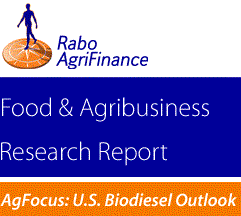 While the proposal to cut the amount of biodiesel and ethanol to be blended into the Nation’s fuel supply has green fuel makers nervous, a new report shows that turmoil at the end of 2013 actually helped biodiesel spike. Financial services provider for agricultural producers and agribusinesses Rabobank Food & Agribusiness Research (FAR) says the Environmental Protection Agency’s (EPA) proposal to adjust the Renewable Fuel Standard (RFS) at the end of last year could actually end up providing an environment for a stable long-term outlook for biodiesel demand
While the proposal to cut the amount of biodiesel and ethanol to be blended into the Nation’s fuel supply has green fuel makers nervous, a new report shows that turmoil at the end of 2013 actually helped biodiesel spike. Financial services provider for agricultural producers and agribusinesses Rabobank Food & Agribusiness Research (FAR) says the Environmental Protection Agency’s (EPA) proposal to adjust the Renewable Fuel Standard (RFS) at the end of last year could actually end up providing an environment for a stable long-term outlook for biodiesel demand
“We saw a record level of biodiesel production in 2013 due to the expiration of the one dollar per gallon tax credit on biodiesel production and an anticipated soybean shortage in 2014,” notes report author and Rabobank analyst Al Griffin.
According the Rabobank U.S. Biodiesel Outlook, the U.S. biodiesel industry is expected to remain commoditized with tightening margins and periods of negative returns. The industry players best positioned for success are those focused on becoming the low cost producer, gaining access to multiple feedstock sources, and accessing adequate working capital to withstand volatile margins.
“Increases in biodiesel production will bolster demand for soy oil, corn oil, canola oil, yellow grease, and palm oil, along with other, less common inputs,” says Griffin. “With biodiesel feedstock being split roughly evenly between soy oil and all other sources, the fats and oils sector will benefit from intensified production.”
The report goes on to point out that while ethanol runs into issues with the blend wall, biodiesel doesn’t really face the same issues. In addition, recent signals from the EPA that it will go back to original RFS mandate levels during 2014 have helped provide the biodiesel optimism in the report.

